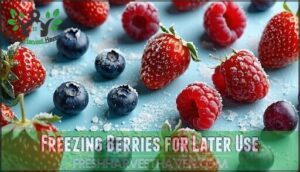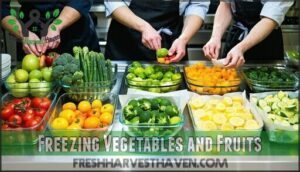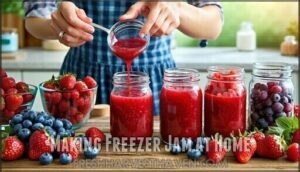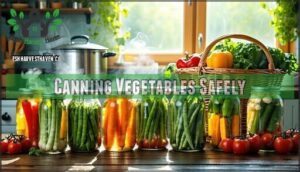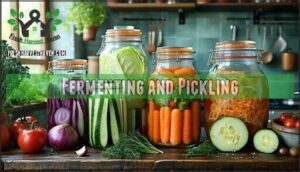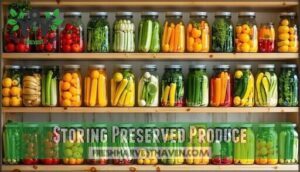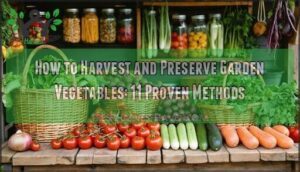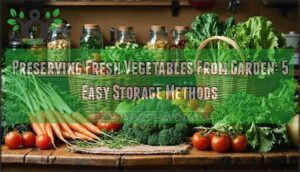This site is supported by our readers. We may earn a commission, at no cost to you, if you purchase through links.
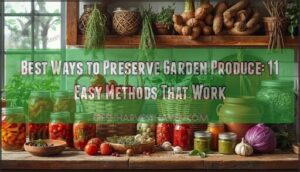 You’ll find eleven proven methods to transform your garden’s bounty into year-round treasures.
You’ll find eleven proven methods to transform your garden’s bounty into year-round treasures.
The best ways to preserve garden produce include drying herbs and vegetables, freezing berries and fruits, canning using water bath or pressure methods, fermenting vegetables for health benefits, and creating pickles and pesto.
Each technique suits different produce types – delicate herbs dry beautifully, while sturdy vegetables excel in fermentation.
Proper storage in root cellars, freezers, or pantries extends shelf life dramatically.
These time-tested methods turn potential waste into pantry gold, saving money while ensuring you’ll enjoy fresh flavors months after harvest.
Master these techniques and discover which preservation secrets work best for your specific crops.
Table Of Contents
- Key Takeaways
- Drying Garden Produce
- Freezing Fresh Produce
- Canning Garden Produce
- Fermenting and Pickling
- Storing Preserved Produce
- Frequently Asked Questions (FAQs)
- How can I preserve my garden harvest?
- How do you keep fresh produce fresh?
- What is the best way to preserve food?
- What is the best way to preserve fruits & vegetables?
- Should you refrigerate garden fresh produce?
- Why should you use garden fresh produce?
- How to store fresh produce from a garden?
- How do you preserve a garden harvest?
- What is the best way to preserve fresh produce?
- How do you preserve fresh produce without Canning?
- Conclusion
Key Takeaways
- Match your preservation method to your produce type – you’ll get better results by freezing berries and blanched vegetables, drying herbs and sturdy vegetables, canning high-acid fruits, and fermenting low-acid vegetables for maximum shelf life and flavor retention.
- Master proper preparation techniques before preserving – you should blanch vegetables before freezing, harvest herbs before they bloom, slice fruits uniformly for dehydrating, and ensure vegetables are completely clean before fermenting to prevent spoilage and maintain quality.
- Focus on proper storage after preservation – you’ll extend shelf life dramatically by using airtight containers for dried foods, maintaining proper freezer temperatures, storing canned goods in cool, dark places, and keeping fermented vegetables submerged in brine.
- Start with simple methods that don’t require special equipment – you can begin preserving immediately using basic techniques like air-drying herbs on racks, freezing berries on baking sheets, making quick pickles with vinegar brines, and fermenting vegetables in salt water.
Drying Garden Produce
Drying your garden produce is one of the simplest ways to capture peak flavors while extending shelf life for over a year.
You’ll remove up to 95% of the water content, which stops bacteria in their tracks and keeps your harvest fresh without taking up precious freezer space, allowing for year-long preservation.
Drying Herbs Easily
You’ll love how simple drying herbs can be! Start by harvesting at the Ideal Harvest Time—before blooms appear—for maximum herb flavor retention. Gently shake off dirt and pat dry if needed.
Air Drying Herbs works perfectly using Herb Drying Racks or cooling racks near breezy windows. This natural method prevents mold while preserving those garden-fresh flavors you’ve worked so hard to grow. For perfect air circulation, consider using a specialized drying apparatus.
Here’s your simple success formula:
- Harvest early morning when oils are most concentrated
- Dry completely until leaves crumble easily between fingers
Once crispy, transfer your perfectly dried herbs to airtight glass jars for Storing Dried Herbs. This beats expensive store-bought seasonings every time!
Drying Vegetables for Long Term
Moving from herbs to heartier produce, vegetable preservation through food dehydration keeps your harvest fresh year-round.
Here’s your roadmap:
- Vegetable Selection: Pick firm, ripe vegetables without blemishes or soft spots for best results.
- Slicing Techniques: Cut vegetables into uniform 1/4-inch pieces to guarantee even drying throughout.
- Drying Methods: Use dehydrating food equipment or drying racks at 130°F for maximum nutrient retention.
- Storage Solutions: Store completely dried vegetables in airtight containers to prevent moisture and spoilage.
- Rehydration Tips: Soak dried vegetables in warm water before adding to soups and casseroles.
Dehydrating Fruits at Home
Within your orchard’s abundance, dehydrating fruits transforms fresh harvests into concentrated treats. Start by slicing fruits thinly—apples, peaches, or berries work beautifully for fruit leather and chips. Different dehydrator types offer various benefits: electric units provide consistent heat while solar versions save energy costs.
Set temperatures between 130°F-150°F for ideal food dehydration. Adjust sweetness levels by adding honey or cinnamon before drying. You can find dehydrating fruit products to help with the process.
Preserving fruits through food preservation methods extends storage duration up to one year when kept in airtight containers. Rehydration tips: soak dried pieces in warm water for baking recipes, bringing back their natural texture while maintaining concentrated flavors.
Freezing Fresh Produce
Freezing is hands-down the easiest way to preserve your garden’s bounty without any fancy equipment or complicated steps.
You’ll lock in most nutrients and flavors while keeping your summer harvest fresh for up to a year – it’s like having a time machine for your vegetables and fruits, which is a great way to enjoy summer harvest throughout the year.
Freezing Berries for Later Use
Flash freezing berries prevents them from turning into a mushy mess later. First, rinse your berries gently and pat them completely dry—wet berries create ice crystals that ruin texture.
Spread them in a single layer on a baking sheet, making sure they don’t touch each other. This dry freezing technique works for all berry types, from strawberries to blueberries.
Pop the tray in your freezer for 2-3 hours until solid, then transfer to freezer bags or containers. This prevents clumping and makes grabbing portions easy.
Berry blanching isn’t needed since berries freeze beautifully raw. With proper freezer burn prevention through airtight storage, your berries maintain excellent nutrient retention and storage time up to 12 months.
Freezing Vegetables and Fruits
Beyond berries, freezing vegetables and fruits requires smart preparation to lock in garden-fresh goodness. Blanching techniques stop enzyme activity—boil vegetables briefly, then shock in ice water. Flash freezing prevents clumping: spread pieces on trays before bagging.
Here’s what proper freezing gives you:
- Summer flavors available year-round for cozy winter meals
- Nutrient retention up to 90% with correct blanching methods
- Money saved by preserving bumper harvests instead of waste
- Convenience of pre-prepped ingredients ready for quick cooking
Best packaging prevents freezer burn—vacuum-sealed bags work great!
Making Freezer Jam at Home
Why settle for store-bought when making freezer jam at home is this simple? You’ll create delicious preserves using Freezer Jam Pectin and your choice of Sugar Alternatives like honey or stevia.
Here’s your foolproof process:
- Mash ripe berries – combine different Fruit Combinations like strawberry-rhubarb for unique flavors
- Mix pectin and sweetener – follow package ratios for perfect consistency in your jelly recipes
- Fill containers – leave headspace for expansion, then freeze immediately
Your homemade jam making adventure creates months of preserving garden produce success. Many appreciate the benefits of local produce in these recipes.
Storage Duration reaches 12 months, and Thawing Tips include overnight refrigeration for best texture in these essential food preservation methods.
Canning Garden Produce
Canning lets you turn your garden’s bounty into shelf-stable treasures that’ll last all year long.
You’ll master water bath canning for high-acid foods like tomatoes and fruits, plus pressure canning for vegetables that need extra heat to stay safe.
Water Bath Canning for Fruits
Water bath canning transforms your fruit selection into shelf-stable treasures.
Master jar preparation by sterilizing equipment and following tested recipes exactly.
High-acid fruits like peaches and berries are perfect candidates for these canning techniques.
Watch for sealing issues during cooling—properly sealed lids won’t flex when pressed.
Recipe variations let you customize sweetness levels.
Store your fruit preservation victories in cool, dark spaces for year-round enjoyment of summer’s bounty.
Canning Vegetables Safely
While fruits work great with water bath canning, vegetables need extra care for botulism prevention.
These low-acid foods require pressure canning, but let’s start with basic safety steps you’ll need:
- Sterilize jars properly – Boil at 180°F for safe canning techniques
- Mind your headspace importance – Leave correct space for proper jar sealing
- Follow tested recipe selection – Make altitude adjustments for your area
Don’t wing it with preserving vegetables – food safety isn’t negotiable.
Using only research-based recipes is vital for safety. Skip reusing lids since warped ones compromise your seal. Clean everything with vinegar solution first.
Master these canning techniques and you’ll preserve vegetables safely every time!
Pressure Canning for Low Acid Foods
Pressure canning transforms dangerous low-acid foods into shelf-stable treasures through safe practices. You’ll need temperatures reaching 240°F—something only proper equipment choices can deliver.
Test your gauge yearly and make altitude adjustments (add 1 psi per 2,000 feet above sea level). Follow tested recipe selection for botulism prevention.
Consider exploring options for purchasing canning supplies to guarantee you have everything needed.
| Food Type | Processing Time (Pints) | Pressure (PSI) |
|---|---|---|
| Green Beans | 20-25 minutes | 10-11 |
| Corn | 55 minutes | 10-11 |
| Carrots | 25 minutes | 10-11 |
| Meat/Poultry | 75-100 minutes | 10-11 |
| Mixed Vegetables | 75 minutes | 10-11 |
Master these techniques for preserving garden produce, and you’ll confidently tackle safe canning of any low-acid foods your garden produces!
Fermenting and Pickling
You’ll love how fermenting and pickling turn your garden’s overflow into tangy, probiotic-rich treasures that last for months.
These time-tested methods also preserve your harvest but actually boost its nutritional value while adding bold flavors to your meals.
Fermenting Vegetables for Health
Transform your garden harvest into probiotic-rich powerhouses through fermentation—your gut will thank you!
Simply submerge fresh vegetables in a 2% salt brine to create anaerobic conditions that encourage beneficial bacteria growth.
The fermentation process takes just 5-7 days at room temperature, naturally boosting gut health while preserving your produce.
Fermenting vegetables offers incredible probiotic benefits, with over 100 types of beneficial bacteria per gram supporting diverse gut microbiota.
The salt brine guarantees fermentation safety by preventing harmful microorganisms.
This ancient preservation method transforms ordinary vegetables into tangy, nutrient-dense fermenting foods that’ll keep your digestive system happy year-round.
Pickling Vegetables at Home
Most vegetables become tangy treasures with simple pickling techniques that’ll make your taste buds dance.
Here’s your foolproof pickling method:
- Create pickling brines: Mix 1 cup vinegar, 1 cup water, 3/4 teaspoon salt, 1 tablespoon sugar
- Add spice combinations like dill, garlic, or mustard seeds for flavor depth
- Complete vegetable prep by cutting produce into uniform pieces for even brining
- Follow safety tips: submerge vegetables completely and refrigerate immediately
These storage methods keep your pickled vegetables crisp for weeks.
Consider early morning harvesting for best results.
Preserving garden produce through food preservation means you’ll enjoy harvest flavors long after summer ends.
Preserving vegetables this way beats store-bought every time!
Making Pesto With Fresh Herbs
While pickling adds tang to your garden harvest, pesto recipes offer another fantastic way of preserving garden produce.
Create Pesto Herb Selection using basil, parsley, or arugula blended with olive oil, garlic, nuts, and cheese.
Control Pesto Texture Control by adjusting oil amounts.
Explore Pesto Flavor Combinations with different herbs and nuts.
Use Pesto Freezing Methods like ice cube trays for portion control.
These Pesto Recipe Variations provide versatile culinary applications that’ll transform your herb preservation game completely.
Storing Preserved Produce
You’ve worked hard to preserve your garden harvest, but proper storage is what keeps all that effort from going to waste.
The right storage methods can extend your preserved foods’ shelf life for months or even years while maintaining their flavor and nutritional value, which is crucial for keeping the flavor.
Storing Dried Fruits and Vegetables
The secret to successful traditional drying lies in smart storage choices.
Airtight containers like mason jars or vacuum-sealed bags prevent moisture removal efforts from going to waste.
Store your dried food in cool, dark places below 60°F for maximum shelf life—think pantry, not countertop.
Temperature impacts can invite mold, while proper moisture control locks in that concentrated flavor concentration you worked hard to achieve.
Pest prevention means checking containers regularly.
Your dehydrating success depends entirely on keeping moisture out after the hard work’s done.
Freezer Storage for Long Term
Your freezer’s like a time machine—it keeps summer’s bounty fresh for months.
Blanching veggies before freezing locks in nutrients and prevents that mushy texture nobody wants. Use airtight containers or heavy-duty freezer bags to fight freezer burn.
When freezing berries, spread them on trays first so they don’t turn into fruity ice chunks.
Chest freezers beat upright models for long-term storage since they hold temperature better during power outages. Label everything with dates—trust me, mystery frozen blobs aren’t appetizing six months later.
Root Cellar Storage for Freshness
Building a root cellar transforms your harvest into year-round freshness.
These underground champions maintain perfect root cellar conditions naturally. Proper handling techniques prevent decay and maintain freshness.
Essential Root Cellar Requirements:
- Optimal Conditions: Keep temperatures 32-40°F with 90-95% humidity for maximum storage duration
- Ventilation Needs: Install proper airflow systems to prevent mold and maintain moisture control
- Produce Selection: Choose unblemished potatoes, carrots, beets, and apples for best results
- Pest Control: Use screens and sealed construction to protect your stored treasures
Tips for Maintaining Freshness
Why stress about spoiled produce when simple tricks keep your harvest fresh longer? Master these garden produce preservation fundamentals for extending shelf life.
| Produce Type | Storage Environment | Humidity Control |
|---|---|---|
| Root vegetables | Cold, moist sand | High humidity (90-95%) |
| Onions/potatoes | Cool, dry, ventilated | Low humidity (60-70%) |
| Leafy greens | Refrigerated, unwashed | Medium humidity (80-85%) |
| Apples/pears | Cold storage | Controlled atmosphere |
| Herbs | Refrigerated, stems in water | High humidity wrapping |
Optimal Harvest Time matters—pick at proper Ripening Stages. Remove greens from roots immediately. Separate Ethylene Gas producers like apples from sensitive vegetables. Never wash until use for fresh produce storage success.
Frequently Asked Questions (FAQs)
How can I preserve my garden harvest?
You can preserve your garden harvest through several tried-and-true methods.
Freezing’s your easiest bet—just blanch vegetables first, then freeze.
Dehydrating removes 95% of water, creating lightweight snacks that last over a year when stored properly in airtight containers.
How do you keep fresh produce fresh?
Americans waste 30-40% of fresh produce annually.
You’ll keep yours fresh longer by storing leafy greens in the crisper drawer, keeping fruits and vegetables separate.
Checking regularly for spoilage to remove bad pieces quickly is also crucial.
What is the best way to preserve food?
You’ll get the best results by matching your preservation method to what you’re storing.
Freezing works great for most produce, canning creates shelf-stable jars, and dehydrating makes lightweight snacks that last over a year, using methods like dehydrating.
What is the best way to preserve fruits & vegetables?
Why let your harvest go to waste when simple preservation keeps flavors alive for months?
You’ll find freezing works best for most fruits and vegetables—just blanch veggies first, then freeze berries on trays to prevent clumping.
Should you refrigerate garden fresh produce?
You’ll want to refrigerate most garden produce right away to maintain freshness.
Leafy greens last 1-2 weeks refrigerated, while peppers stay crisp for two weeks and apples keep for a month.
Why should you use garden fresh produce?
Sure, fresh produce seems like extra work, but you’re getting peak nutrition and flavor that store-bought can’t match. Your garden veggies retain maximum vitamins and taste amazing.
How to store fresh produce from a garden?
Store fresh garden produce by refrigerating leafy greens and peppers immediately.
Freezing berries on trays first, blanching vegetables before freezing, are crucial steps for preserving specific types of produce.
Keeping root vegetables in cool, dark places is essential for ideal freshness and longevity.
How do you preserve a garden harvest?
Time to turn your garden’s bounty into lasting treasures!
You can freeze most vegetables after blanching, dehydrate fruits and herbs using racks or dehydrators.
can high-acid foods like tomatoes, or ferment vegetables into probiotic-rich delights.
What is the best way to preserve fresh produce?
Dehydration offers the longest shelf life, removing 95% of water while retaining nutrients.
Freezing maintains freshness for up to a year.
Canning creates shelf-stable foods. Choose based on your produce type and storage preferences.
How do you preserve fresh produce without Canning?
Like a squirrel storing nuts for winter, you can freeze, dehydrate, or ferment your harvest.
Freeze berries on trays, dry herbs on racks, or pickle vegetables in salt brine for probiotic benefits.
Conclusion
Yesterday’s garden overflow becomes today’s empty pantry – unless you master these preservation techniques.
You’ve discovered the best ways to preserve garden produce through drying, freezing, canning, and fermenting methods that fit any harvest.
Whether you’re storing herbs in your pantry or fermenting vegetables for winter, these eleven techniques transform seasonal abundance into year-round nutrition.
Your garden’s hard work deserves to last beyond summer’s end, utilizing effective methods for year-round nutrition.

